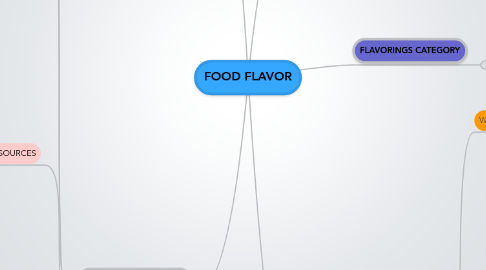
1. WHAT IS
1.1. property of food or beverage that causes the simultaneous reaction of taste on the tongue and odour in the olfactory center of the nose
1.2. a collective sensory experience resulting from the combination of the four basic tastes (+umami), aroma and physical factors
1.3. flavour agent - those substances that, when added to food or beverage impart flavor
2. NATURAL FLAVOURINGS
2.1. essential oil, oleoresin, essence or extractive , protein hydrolysate, distillate, or any product of roasting,heating or enzymolysis
2.2. any natural flavour is normally quite complex,with dozens or hundreds of chemicals interacting to create taste/smell.
2.3. character-impact compounds- have one or a few dominant chemical components. Ex:Octyl Acetate-orange flavour
2.4. SOURCES
2.4.1. Herb and spices
2.4.1.1. herb --aromatic plants, such as basil,mint,oregano and thyme
2.4.1.2. spices --other highly aromatic plants:capsium(pepper), cinnamon,etc.---consist of specific parts like fruits,roots and barks.
2.4.1.3. naturally occuring essential oil, e.g. eugenol,cinnamaldehyde and menthol & non-volatile constituents contribute to characteristic flavours
2.4.1.4. essential oils--prepared by steam distillation of the dried spices & contain the volatile flavour compounds
2.4.1.5. oleoresins--the solvent extracts of the spices & contain the volatile essential oil + non-volatile resinous material
2.4.1.5.1. ADVANTAGES OF OLEORESINS OVER CONVENTIONAL SPICES
2.4.2. Vanilla
2.4.2.1. contain vanillin, as well as other aromatic compounds which give natural vanilla it's distinctive top-notes
2.4.2.2. vanillin content of vanilla can range from 0.5 to 2.0%
2.4.2.3. the strength of vanilla is indicated by 'fold' (max:4 fold)
2.4.2.4. enhance fruit flavours in may dairy and beverage application
2.4.2.5. enhances the sweetness perception of food.(bakery products)
2.4.2.6. vanilla softens or round out harsh, bitter notes in most chocolate applications such as ice creams ,cakes and syrups.
2.5. REACTIONS/PROCESS FLAVOURS
2.5.1. flavouring that have been produced by subjecting selected raw materials to heat which result in heat-induced reactions and fat degradation.
2.5.2. roasted ,caramelized, bready, meaty or nutty
2.5.3. 2 main reactions--direct caramelization of sugars and maillard reactions
2.5.4. savoury products:sauces,gravies,snacks,soups,ready meals and meat products
2.6. DISADVANTAGES
2.6.1. high cost--sources usually imported.The yield often low and extraction process costs must be recovered.
2.6.2. low intensity or impact--large quantities must be used in products
2.6.3. flavour variation--degree of ripeness at harvesting, changes during processing-give off-notes
2.6.4. flavour profile- unwanted notes or an undesirable balance to the flavour profile
2.7. PROCESS FOR OBTAINING IT
2.7.1. distillation- obtain flavour from plant sources
2.7.2. extraction- obtain animal flavours,vegetables flavours
2.7.3. biotechnology-fermentation.enzyme modification
2.7.4. concentration-extracts,fruits juices
3. REASON USING IT
3.1. to impart the characteristics flavour of the flavourings
3.1.1. vanillin to give flavour of vanilla to ice cream
3.2. to augment, complement, or modify the flavour
3.2.1. vanillin to modify the flavour of chocolate
3.3. to mask the original flavour
3.3.1. anise to cover bitter medicinals
3.4. to compensate for the flavours dissipated during processing
3.4.1. the loss of flavour due to heating while baking
3.4.2. the lack of the roast note in microwave cooking
3.5. the form of the natural material may not permit it to be used in the finished product
3.5.1. ginger roots cannot be used as such to produce a beverage but must be extracted for use in soft drink
4. FLAVORINGS CATEGORY
4.1. natural flavouring substances
4.1.1. obtained from naturally occuring plant material or natural sources by biotechnological,microbiological or physical processes.
4.2. natural-identical flavouring substances
4.2.1. obtained by synthesis or isolated through chemical processes from a natural aromatic material and are chemically identical to a substance present in natural products
4.3. artificial flavouring substances
4.3.1. chemically synthesised, but so far have not been found to exist in nature
5. FLAVOUR ENHANCEMENT
5.1. What does it mean?
5.1.1. increasing overall perception of flavour
5.1.2. improving the quality of a flavour
5.1.3. making flavour nicer
5.1.4. delivering on the promise
5.1.5. "brightening the flavour"--make it more distinct,pleasant and noticeable
5.1.6. reinforces the character of the main flavour
5.1.7. improving the liking or perception of a flavour
5.1.8. may impart taste or flavour of a food
5.2. Flavour Potentiators/Enhancers-- a compound with no intrinsic flavour of its own, but with the ability to enhance the perception of flavour
5.2.1. Monosodium Glutamate(MSG)
5.2.1.1. sodium salt of glutamic acid, an amini acid present in most proteins
5.2.1.2. to enhance flavour, the glutamate must be in its free form and in its L-configuration
5.2.1.3. produced through fermentation of various substrates, including molasses and corn syrup
5.2.1.4. can be found in yeast extracts and hydrolyzed vegetable protein(HVP)
5.2.1.5. pH 5.5 -8.0, may loss effectiveness high temp.
5.2.2. Yeast Extracts
5.2.2.1. Autolyzed yeast--yeast that has been ,in effect,self-digested.
5.2.2.2. produced through the hydrolysis of peptide bonds by naturally accuring enzyme present in the edible yeast or by addition of food grade enzymes
5.2.2.3. Autolyzed yeast extract results from a process that removes the insoluble cell wall sacs and leaves a high-protein, water-soluble product. When solubility is required, a yeast extract must be used.
5.2.3. Hydrolyzed Plant and Vegetable Protein(HPP/HVP)
5.2.3.1. HVP--consist of 40-45% salt,9-12% glutamic acid and other flavouring
5.2.3.2. manufactured by acid hydrolysis of high-protein fractions from various grains and other plant materials
5.2.3.3. more expensive and has less flavour intensity
5.2.4. Nucleotides
5.2.4.1. Disodium-5'-inosinate(IMP)--isolated from bonito tuna
5.2.4.2. Disodium-5'-guanylate(GMP)--isolated from shiitake mushroom broth
5.2.4.3. MSG and nucleotides often used in synergistic combinations to enhance flavours (0.2-0.3% in finished product)
5.2.4.4. 50:50 blend of MSG and IMP gives 8 times more flavour-enhancing effect compared to MSG alone
5.2.4.5. susceptible to degradation at moisture levels above 60%. Major losses can result,particulary in foods high in phosphatase activity.
5.2.5. Maltols and ethyl maltol(sweetness petentiator)
5.2.5.1. can enhance teh flavour system of sweet goods
5.2.5.2. sugar can be reduced from 5% to 15% with 15ppm maltol
5.2.5.3. ability to suppress and even eliminate undesirable acid bite and bitter notes
5.2.5.4. minimize bitter aftertaste
5.2.5.5. help contribute brown/ cooked flavour to microwave foods
